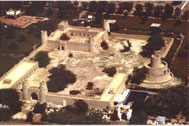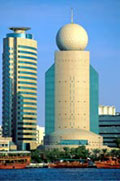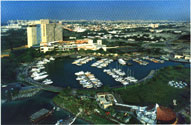Abu
Dhabi
Abu
Dhabi
is the largest of the seven Emirates in the UAE, with an area of 68,000
sq. kms, constituting 86% of the UAE . Abu Dhabi City, which is the
capital of the UAE, is an island on the Gulf with  an
area of about 60 sq. kms. It comprises the islands of Das, Seer Bani
Yas, Mubarraz, Dalma, Saadiyat and Umm Al Nar. The Emirate has other
cities like Dhafra, Ruwais and Wathba in the Western sector.
an
area of about 60 sq. kms. It comprises the islands of Das, Seer Bani
Yas, Mubarraz, Dalma, Saadiyat and Umm Al Nar. The Emirate has other
cities like Dhafra, Ruwais and Wathba in the Western sector.
The Eastern sector includes Al Ain, which has a series of mountains
having natural spring water which runs underground.
Al
Ain city is distinguished for the archaeological sites at Hili,
green pastures, and also the Emirates University. Its own International
Airport was inaugurated in 1994. Al Ain also has a number of Parks,
a Zoo and a Sports City at Hili.

Foreign Trade and Facilities:
Abu Dhabi Emirate is regarded as a very important center of the re-export
trade since it shares borders on the land with Saudi Arabia, Qatar
and Oman. This is assisted by the fact that it has the required infrastructure
including modern ports and airports, and a well-developed road network
with modern fly-overs, which links the Emirates of the country with
the other member countries of the Gulf Co-operation Council.
The fact that the economy allows for free trade and the absence of
taxes and duties has made Abu Dhabi a center of attraction for both
investment and business, since it also occupies a strategic location
in the Gulf, and lies almost mid-way between the continents of Europe
and East Asia. This has led to the attraction of investments and traders
from all over the world.
Accordingly, there has been an appreciable rise in the economic prosperity
and progress in the Emirate in different economic sectors particularly
in trade.
It is expected that the present upswing in the economy would continue
in the forth-coming years. It wouldbe mainly due to the strategic
location of Abu Dhabi as a center of re-export trade in the region.
Agriculture:
The agricultural sector received the special attention of the President,
His Highness Sheikh Zayed Bin Sultan Al Nahyan, and in accordance
with his instructions investments were allocated for this sector.
The Nationals also played an active role in developing this sector
by implementing the belief of H.H. the President, that the agricultural
sector constitutes an important economic enterprise, thereby contributing
to the overall revenue of the
country.
The Ministry of Agriculture & Fisheries has played an important
role in developing this sector, by providing many facilities such
as consultation and long term loans to the farmers, in addition to
the supply of water for irrigation purposes, and construction of reservoirs
and their maintenance. The efforts exerted over the recent years resulted
in substantial accomplishments. The result was that the cultivated
land area increased from 14,100 hectares in 1972 to 72,374 hectares
in 1994. Meanwhile, the value of the agricultural production went
up from Dh. 154 million, in 1972 to 4,210 in the year 1994.
Oil
and gas sector:
The UAE is one of the principal producers and exporters of crude oil
and natural gas in the world. The oil sector has been given substantial
importance by the Government due to the crucial role it plays, and
since it is the main financer for the developmental process. The sector's
affairs are well organized, with all output and export operations
being subject to accurate planning as dictated by the country's interest,
and ensuring realization of the main objectives in the future.
Despite the turbulence that prevailed over the world oil markets during
the recent years, the programmes of expansion and development of the
crude oil installations proceeded according to original plans. The
aggregate volume of investments carried out in this field during the
years 1992, 1993 and 1994 were approximately Dhs. 7.5 billion, Dhs.
7.9 billion and Dhs. 7.8 billion respectively. The contribution of
the Crude Oil Sector to the country's Gross Domestic Product (GDP)
has been very high.. In 1972, the revenue of this sector was Dhs.
4.1 billion, while in the year 1994 it reached Dhs. 45.2 billion,
though its individual contribution decreased in comparison to that
of the other economic
sectors.
Natural gas is of no less importance than crude oil as a source of
energy and a raw material for many industries. It is used in two ways
it is either liquefied and exported, or directed towards petrochemical
industries. In order to benefit from this national wealth, the Government
set up many projects at Das Island, Jebel Ali, Ruwais and other
places.
The Emirate of Abu Dhabi is the principal oil producer and reservoir
of crude oil in the UAE. It possesses 11% of the world's oil reserves.
According to recent statistics, its oil reserves are estimated to
be more than 100 billion barrels, while the natural gas reserves are
estimated to be 57.6 billion cubic meters.
Industry:
The industrial sector is regarded as a new development in the country.
The Government has given a special importance to this sector particularly
since it offers one of the options with regard to the development
of a production sector. Accordingly, there have been major investments
in gigantic industrial projects, with the Government encouraging the
private sector to build up the industrial sector with many large-scale
projects. The Government has not only provided assistance, but also
various facilities through the Emirates Industrial Bank.
The Central Bank report shows that the Industrial sector contributes
heavily in improving the Gross National Product of the country. In
Abu Dhabi, Government managed industries are presently the largest,
with the GIC General Industries Corporation being in direct control
of these industries, which play an important role in the development
of industry in the Emirate. The GIC is also responsible for charting
out a strategy for industry in the Emirate and encouraging the private
sector and the present industrial ventures in Abu Dhabi.
The most important industrial units managed by the corporation are
the Al Ain Cement Plant, the Abu Dhabi company for flour and animal
fodder, the Abu Dhabi factory for plastics and pipes, the Abu Dhabi
plastics and construction block, and the construction block manufacturing
plant at Wathba.
Transportation
and Warehousing :
The Transportation and Warehousing sector plays an important role
in the growth of the UAE. An excellent road network links the different
parts of the country and highly sophisticated means of communication
links it with the outside world. This is in addition to efficient
warehousing capacity, which meets the substantial growth in trade.
There is a large number of refrigerators, stores and huge warehouses.
Due to its influence on the economic and social activities in general,
this sector has been given special importance by the Government, with
substantial investments being allocated to execute the projects of
this sector. The UAE now possesses a modern, developed and highly
efficient transportation and storage sector. It keeps abreast of the
latest developments in the transportation and communication sciences.
The UAE airports are equipped with the latest systems, and operate
in accordance with the most advanced quality standards.
The road networks, highways, fly-overs are highly efficient, and the
seaports possess the latest machinery for handling of goods and their
loading, unloading and storage.
Mina
Zayed:
Mina Zayed contributes to the growth of the economy with its positive
role in regulating the operations of import and export. Mina Zayed
is very well-equipped with all the potential equipment and instruments
to support the economic projects for development in the country. Mina
Zayed is located in the Northeast sector of the island of Abu Dhabi,
and began its formal operations from June, 1972. The port has 21 berths,
which are 4,300 meters long, and the depth is between 9 and 11.5 meters.
The Port is expanding its facilities and potentials every year and
is presently handling cargo load of more than 5 million tons annually.
This includes receiving and handling of all kinds of ships, vessels,
general cargo and oil rigs.
 Three
Industrial Zones in Abu Dhabi, Al Ain and Ruwais
Three
Industrial Zones in Abu Dhabi, Al Ain and Ruwais
The efforts exerted by the Government of Abu Dhabi Emirate towards
diversifying the sources of national income thereby ceasing reliance
on oil as the sole source of income, and with the aim of encouraging
and developing the UAE industrial sector in its various aspects. This
led to the adoption of a resolution by His Highness Shaikh Khalifa
Bin Zayed Al Nahyan, Abu Dhabi Crown Prince, Deputy Supreme Commander
of the Armed Forces and Chairman of the Executive Council, to establish
three industrial zones in Abu Dhabi Emirate to be located at Abu Dhabi,
Al Ain and Ruwais.
The construction process will be supervised by the GIC in Abu Dhabi,
which will co-ordinate with the Municipality Departments of Abu Dhabi
and Al Ain so as to determine the appropriate sites and land areas
required to set up the three zones. His Highness also approved allocation
of Dhs. 100 million to provide the industrialists with soft loans.
Accordingly appropriate rules and means shall be laid down so as to
ensure provision and repayment of the loans through proper means.
The GIC is in charge of laying down the criteria and rules of giving
loans to industrialists. Meanwhile, the authorities concerned in the
Emirate are planning to set up the new industrial cities in the vicinity
of seaports, highways and areas that have civic communities.
The Government of the Abu Dhabi Emirate intends to focus on the industrial
projects that would positively contribute to increasing income on
the public economy level. On their part, the parties concerned in
the Emirate will provide many incentives for the projects that would
contribute to increasing the national income. Most prominent of these
incentives are making available the necessary utilities at subsidized
rates; giving them priority as regards the allocation of industrial
plots located in distinct sites against appropriate leasing fees;
providing soft loans; granting tax exemption on their imports of raw
materials and equipment so as to enable these pioneering projects
to realize utmost success and shoulder their ways towards the local
and regional markets.
The Abu Dhabi National Oil Company (ADNOC) has developed the first
petro-chemical complex in the country aimed at meeting the requirements
of the growing market for petro-chemical products in the world. This
petro-chemical complex along with several other industrial projects
including ship building, aircraft maintenance, development of electrical
power, electronics industry and other Offset programmes are likely
to make Abu Dhabi the focal point of trade and industry in the region.
Energizing
the future:
One of the major projects being launched at present is the development
of the LPG from the Bab field. According to the present provision,
1.5 million tons of associate gas is to be produced from the on-shore
Bab field. This gas is mainly to be utilized for the ambitious projects
for generating electrical power and desalinating seawater.
The gigantic project has also envisaged taking the gas from Bab through
Tawelah to Dubai. The 120-km pipeline is expected to add a new dimension
to the industry of the UAE. Abu Dhabi's gas is expected to provide
the industry in the UAE with the basic form of energy required to
run the future high-tech industries.
The Liquid Natural Gas (LNG) coming mainly from the offshore fields
is also being upgraded to serve new markets in the growing demand
for gas in the fast developing states of East Asia. After Japan, South
Korea and countries like Thailand may become potential markets for
Abu Dhabi's Gas. The major feature of development would also focus
on the development of the shipyard at Musaffah. Here in co-ordination
with a very well known international US company, ships and vessels
up to 10,000 tones are to be fabricated. This would make Abu Dhabi
a pioneer center for ship building in the region. These relatively
smaller ships and vessels would mainly serve the oil and gas industry
as tug boats, supply vessels and mobile workshops to serve the oil
fields lying off-shore. In doing so, Abu Dhabi would attract the business
of oil field supplies in the region, which is known to have 60% of
the world's energy reserves.
Maintaining
the future:
Another significant development would be in the field of aircraft
maintenance. The aircraft would also prove to be a major source of
transport and communication, in developing the energy industry. The
project, which is being launched with a very well known international
company, is expected to make Abu Dhabi an all important center for
aircraft maintenance and repair.
All these projects and several others would put Abu Dhabi in the front
seat of the energy industry, both in terms of oil and gas and also
as a major producer of petro-chemicals which would serve the high-tech
development of industry all over the world.
Another significant development, which is underway, concerns the Sadiyat
Island project, which is expected to open a new era in the history
of commerce in the region.
The US$ 3 billion project envisages the expansion of Sadiyat and the
surrounding area into a vast storage and warehousing facility.
The object is to make the region an important conduit for re-export
and transit trade. With the increasing frequency of ship movement,
and with the Gulf region becoming perhaps the most active and busy
area for international commerce, Sadiyat would serve as one of the
key focal points where exporters would be able to have warehousing
facility to store their products, before being targeted for the consumer
market.
Future
Dynamics:
The Abu Dhabi authorities are convinced that Sadiyat would ultimately
become one of the most important transit points of trade on the world
map. This is in view of the fact that some of the ambitious projects
in the field of energy and power are being launched around the same
location.
This, coupled with the Musaffah shipyard can very well turn Abu Dhabi
into a viable entity in regional and international commerce. Another
important industrial development is likely to take place in the food
processing business. The Abu Dhabi planners are aiming to diversify
revenue and to move swiftly towards gaining self-reliance.
Food processing technology is being developed fast to ensure that
farm and fish products are exported to earn revenue. Already the agro-industry
of Abu Dhabi has produced remarkable results. The Planning Authorities
in the UAE say that 40% of the GDP now comes from the private sector.
With the privatization campaign in full swing and many major public
sector projects being handed over to the private sector, a major upsurge
in the economy is expected. The surplus liquidity in the market is
being regulated and utilized to serve national development.
Avenues
for trade:
One of the very significant if not unique features of trade and commerce
in Abu Dhabi is the combination of business with the defence requirements.
This is very much evident from the biennial International Defence
Exhibition - IDEX which commenced in 1993 after the second Gulf conflict,
and which presents new facets for trade - as probably for the first
time civilian commerce has been linked with the largest business sector
of the world involving sales of defence equipment estimated to be
around US$ 1 trillion annually.
IDEX '93, '95 and '97 have proved beyond doubt the significance of
this combination of the two business sectors. Deals and transactions
involving billions of Dirhams have been conducted through these exhibitions
which have now become the focal point of trade involving defence equipment
and the requirements of industry which provides hi-tech hardware and
electronic software.
